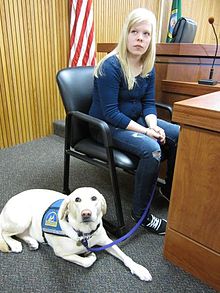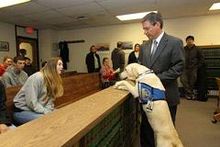- Courthouse dog
-
Courthouse dogs are professionally trained facility service dogs that assist crime victims, witnesses and others during the investigation and prosecution of crimes. In addition to the courthouse, these dogs work in child advocacy centers, district attorney offices, and law enforcement settings. Courthouse dogs also provide assistance to Drug Court and Mental Health Court participants during their recovery from drugs, alcohol, mental illness and post-traumatic stress syndrome.
The handlers of these dogs are criminal justice professionals such as district attorneys, law enforcement officers, forensic interviewers, psychologists, social workers and victim advocates. When courthouse dogs are off duty, they are beloved pets that live with their primary handlers. Nonprofessional handlers are not utilized with courthouse dogs due to the confidential nature of some proceedings, and because the presence of lay people during the investigation of a crime and in the courtroom may create legal issues.
Contents
Typical work done by a courthouse dog
- Greeting children and parents who have come into a child advocacy center to initiate investigation of child sexual abuse
- Accompanying a child (age 4 – 17) during a forensic interview, where the child explains to a trained interviewer the details of an incident of sexual abuse or a crime of violence
- Accompanying a child during the various phases of the investigation and prosecution of crime, including a defense interview, a competency hearing, and a courtroom trial
- Greeting members of the public throughout the courthouse
- Attending drug court, mental health court, and other restorative justice proceedings to provide an element of calm to people with disabilities and individuals in drug withdrawal.
- Accompanying vulnerable adult crime victims, including rape victims, developmentally delayed adults, and the elderly during court proceedings
- Providing emotional comfort to family members of homicide victims during the trial and sentencing of the offender (see Stilson Comforts at Sentencing)
- Providing a sense of normalcy during juvenile court proceedings.[1]
How are courthouse dogs trained?
Courthouse dogs are usually bred, raised and trained by service dog organizations that are members of Assistance Dogs International, such as Canine Companions for Independence or Assistance Dogs of the West. Most of these dogs are either golden or Labrador retrievers or a combination of the two breeds. These dogs have typically spent eighteen months being raised by a volunteer puppy raiser with weekly obedience classes and had six months or more of work with a professional dog trainer. During this time the organization’s trainers carefully assess which facility assistance dogs have the best temperament to work in a courthouse environment.[2] A successful courthouse dog will have a quiet, calm demeanor and be self-confident. The dog will also need to be adaptable, highly social and work independently with many individuals throughout a typical day and have multiple handlers. In addition to the dog’s basic training, that should involve passing a public access test, the dog should be able to tolerate people wearing a variety of clothing from all walks of life, angry people, drug abusers, children who invade boundaries, erratic behavior, and emotionally charged situations. Most importantly, the dog should know when to engage with people in public and when to become almost invisible for extended periods of time during child forensic interviews and courtroom proceedings.[3] The courthouse dog’s handler receives intensive training before graduating from the service dog organization with their dog. In order to protect the jurisdiction and handler of the dog from a lawsuit, these dogs often carry a minimum of one million dollars in liability insurance. Many qualified dogs carry such policies as a part of the certification process, such as the courthouse dogs provided by Canine Companions for Independence.[4]
Are courthouse dogs legally neutral?
While prosecuting attorneys, law enforcement officers and victim advocates support the use of courthouse dogs assisting crime victims and witnesses while they testify in court, defense attorneys object to their use out of concern that it is prejudicial to their clients.[5] The objection is usually based on the argument that the presence of the dog may make the prosecution witness more appealing to the jury. However courthouse dogs are for everyone. If this type of dog is available and the witnesses can demonstrate to the judge that the presence of a courthouse dog would facilitate their ability to testify in court, then the dog should be made available to everyone including defendants.[6]
The National Crime Victim Law Institute suggests that this jury instruction regarding the presence of the dog in the courtroom be provided to the jurors before deliberations to overcome unfair prejudice to either the defense or prosecution.
“Testifying in court is an unfamiliar and stressful event for most people; these dogs are used in a courthouse setting to help reduce witness anxiety and are available to any witness who requests one.”
History of courthouse dogs
- Firsts in using trained dogs to assist victims and witnesses in the criminal-justice system:
- 1989: A retired Seeing-Eye dog Sheba assisted child sexual-abuse victims in the Special Victims Bureau of the Queens, NY, District Attorney’s Office. (See Dogs of the Zero - Sheba)
- 1990: Vachess, a German shepherd, made a courtroom appearance at the feet of a 5-year-old girl in a preliminary hearing in Rankin County, MS. (See Dogs of the Zero - Vachess).
- 2003: Jeeter, a golden Labrador retriever service dog, accompanied twin sisters into King County Superior Court during competency hearings and trial testimony (See Bark Magazine - Dogs lend comfort to kids in court).
- 2004: Canine Companions for Independence became the first assistance dog organization to place a facility dog (Ellie, a Labrador retriever mix) to work in a prosecutor’s office, in Seattle (See Seattle Times - Dogs in the Courtroom).
- Since 2003 the use of courthouse dogs has spread throughout the United States and internationally.
Representative courthouse dogs
- Ellie from Canine Companions for Independence (placed 2004) - Primary handler King County Senior Deputy Prosecuting Attorney Page Ulrey- Office of the King County Prosecuting Attorney, Seattle, WA (see Dogs Give Prosecutors a Hand in Difficult Cases).
- Stilson from Canine Companions for Independence (placed 2005) -Primary handler Victim Advocate Heidi Potter-Office of the Snohomish County Prosecuting Attorney, Everett, WA (See Courthouse dogs comfort young crime victims).
- Dory from Pawsitive Teams (placed 2008) -Primary handler Police Officer Lynn Chavez, San Diego Police Department (See Dory the Dog Honored as Good Citizen).
- Mya from Indiana Canine Assistant Network (placed 2010) -Primary handler- Deputy Prosecuting Attorney Judi Johnson, Boone County Prosecuting Attorney (see Full Circle – Prison Inmates Train a Courthouse Dog).
- Cooper from Assistance Dogs of the West (placed 2010) -Primary handler- Hope Henessey, Court Appointed Special Advocates of Lea County, Hobbs, NM (see Court Program Uses Service Dogs).
- Simon from Support Dogs Inc. St. Louis Missouri (placed 2009) -Primary handler-Diane Silman executive director of the Ozark Foothills Child Advocacy Center (see History Continues to be Made in Assistance Dog Program).
- Kerris from Canine Companions for Independence (placed 2009) -Kevin Kelly, Senior Deputy Prosecuting Attorney Office of the Kitsap County, WA (see Newest hand in Kitsap prosecutor’s office gives a yip about crime).
- Princess from Canine Partners for Life (placed 2009) - Faith Burger, Victim Advocate District Attorney Centre County, PA (see Dog eases victims’ burdens).
- Peseta from Bocalan Confiar (placed 2009) - Policía de Investigaciones de Chile (PDI) and Servicio Nacional de Menores (SENAME) of the Ministry of Justice, child–sexual abuse treatment organization (see Courthouse Dogs Go South).
References
- ^ Grey, Jamie. "Courthouse dog helps child victims". KTVB. kvtb.com. http://www.ktvb.com/news/Courthouse-dog-helps-child-victims--116285974.html. Retrieved 21 September 2011.
- ^ Ban, Charlie. "Dog Puts Victims at Ease in the Courtroom in Maricopa County". NACO County News. National Association of Counties Newsletter. http://www.naco.org/newsroom/countynews/current%20issue/2-14-11/pages/modelprogramsformthenation%27scounties.aspx. Retrieved 21 September 2011.
- ^ Gray, Kathleen. "Dogs help provide cupport in courtrooms". USA Today. USA Today. http://www.usatoday.com/news/nation/2010-02-22-court-dogs_N.htm. Retrieved 21 September 2011.
- ^ Henry, Chris. "Newest Hand in Kitsap Prosecutor's Office Gives a Yip About Crime Victims". Kitsap Sun. Scripps Interactive Newspapers Group. http://www.kitsapsun.com/news/2010/apr/29/newest-hand-in-kitsap-prosecutors-office-gives-a/. Retrieved 21 September 2011.
- ^ Wiessner, Dan. "U.S. courtroom dogs spark legal debate". Reuters. Reuters. http://www.reuters.com/article/2011/09/12/us-usa-courtoom-dogs-idUSTRE78B4KN20110912. Retrieved 21 September 2011.
- ^ Glaberson, William. "By Helping a Girl Testify at a Rape Trial, a Dog Ignites a Legal Debate". New York Times. New York Times. http://www.nytimes.com/2011/08/09/nyregion/dog-helps-rape-victim-15-testify.html. Retrieved 21 September 2011.
External links
Categories:- Working dogs
Wikimedia Foundation. 2010.



